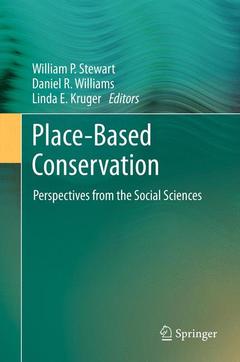Description
Place-Based Conservation, 2013
Perspectives from the Social Sciences
Language: English
Subjects for Place-Based Conservation:
264 p. · 15.5x23.5 cm · Paperback
Description
/li>Contents
/li>Comment
/li>
The concept of ?Place? has become prominent in natural resource management, as professionals increasingly recognize the importance of scale, place-specific meanings, local knowledge, and social-ecological dynamics. Place-Based Conservation: Perspectives from the Social Sciences offers a thorough examination of the topic, dividing its exploration into four broad areas.
Place-Based Conservation provides a comprehensive resource for researchers and practitioners to help build the conceptual grounding necessary to understand and to effectively practice place-based conservation.
1: The Emergence of Place-Based Conservation
Daniel R. Williams*, William P. Stewart, and Linda E. Kruger
Part I: Conceptual Issues of Place-Based Conservation
2: Science, Practice and Place
Daniel R. Williams*
3: Conservation That Connects Multiple Scales of Place
Courtney Flint*
4: Organizational Cultures and Place-Based Conservation
Patricia A. Stokowski*
5: Community, Place, and Conservation
Gene L. Theodori* and Gerard T. Kyle
Part II: Experiencing Place
6: Sensing Value in Place
Herbert Schroeder*
7: Place Meanings as Lived Experience
James R. Barkley* and Linda E. Kruger
8: Personal Experience and Public Place Creation
Tyra Olstad*
9: Volunteer Meanings in the Making of Place
Ben Amsden*, Richard C. Stedman, and Linda E. Kruger
Part III: Representing Place
10: Integrating Divergent Representations of Place into Decision Contexts
Damon M. Hall*, Susan J. Gilbertz, Cristi C. Horton, and Tarla Rai Peterson
11: Sharing Stories of Place to Foster Social Learning
William P. Stewart*, Troy D. Glover, and James R. Barkley
12: Rural Property, Collective Action, and Place-Based Conservation
Paul Van Auken* and Shaun Golding
13: Whose Sense of Place? A Political Ecology of Amenity Development
Patrick T. Hurley*
Part IV: Mapping Place
14: Participatory Place Mapping in Fire Planning
Michael Cacciapaglia and Laurie Yung*
15: Participatory Mapping of Place Values in Northwestern Ontario
Norman McIntyre*, Perrine Lesueur and Jeff Moore
16: Place Mapping to Protect Cultural Landscapes on Tribal Lands
Alan Watson*, Steve Carver, Roian Van Ness, Tim Waters, Kari Gunderson, and Brett Davis
17: Place Attachment for Wildland Recreation Planning
Neal Christensen* and James Burchfield
18: From Describing to Prescribing: Transitioning to Place-Based Conservation
William P. Stewart*, Daniel R. Williams, and Linda E. Kruger
Presents a human-centered approach to conservation that incorporates and draws on the deepest meanings of place
Draws on such diverse disciplines as human geography, urban planning, communications, environmental psychology, rural sociology, geographic information systems, and community development
Provides strategies for involving the public in conservation planning decisions
Benefits land-use planners, conservationists, researchers and policy makers




